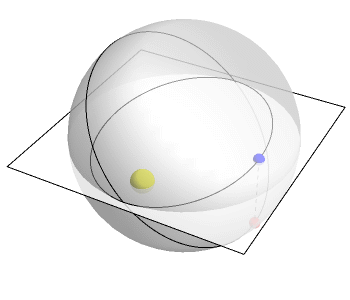Given a spherically symmetric potential $V: {\bf R}^d \to {\bf R}$, smooth away from the origin, one can consider the Newtonian equations of motion $$ \frac{d^2}{dt^2} x = - (\nabla V)(x)$$ for a particle $x: {\bf R} \to {\bf R}^d$ in this potential well. Under the spherical symmetry assumption, one has conservation of angular momentum (as per Noether's theorem, or Kepler's second law), and using this one can perform a "symplectic reduction" and reduce the dynamics to an autonomous second order ODE of the radial variable $r = |x|$ as a function of an angular variable $\theta$; see for instance https://en.wikipedia.org/wiki/Kepler_problem#Solution_of_the_Kepler_problem. In general (assuming an attractive potential and energy not too large), the energy surfaces of this ODE are closed curves, and this leads to the radial variable $r$ depending in a periodic fashion on the angular variable $\theta$, provided that one lifts the angular variable from the unit circle ${\bf R}/2\pi {\bf Z}$ to the universal cover ${\bf R}$.
In the special case of the inverse square law $V(x) = -\frac{GM}{|x|}$, it turns out that the period of the map $\theta \mapsto r$ is always equal to $2\pi$, which means in this case that the orbits are closed curves in ${\bf R}^d$ (whereas for almost all other potentials, with the exception of the quadratic potentials $V(x) = c |x|^2$, the orbits exhibit precession). Indeed, as was famously worked out by Newton (by a slightly different method), the calculations eventually recover Kepler's first law that the orbits under the inverse square law are ellipses with one focus at the origin.
The calculations are not too difficult - basically by applying the transformation $u = 1/r$ one can convert the aforementioned ODE into a shifted version of the harmonic oscillator - but they seem rather "miraculous" to me. My (rather vague) question is whether there is a "high level" (e.g., symplectic geometry) explanation of this phenomenon of the inverse square law giving periodic orbits without precession. For instance, in the case of quadratic potentials, the phase space has the structure of a toric variety ${\bf C}^d$ (with the obvious action of $U(1)^d$), and the Hamiltonian $\frac{1}{2} |\dot x|^2 + \frac{c}{2} |x|^2$ is just one linear component of the moment map, so the periodicity of the orbits in this case can be viewed as a special case of the behaviour of general toric varieties. But I wasn't able to see a similar symplectic geometry explanation in the inverse square case, as I couldn't find an obvious symplectic torus action here (in large part because the period of the orbits varies with the orbit, as per Kepler's third law). Is the lack of precession just a "coincidence", or is there something more going on here? For instance, is there a canonical transformation that transforms the dynamics into a normal form that transparently reveals the periodicity (similar to how action-angle variables reveal the dynamics on toric varieties)?

